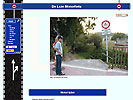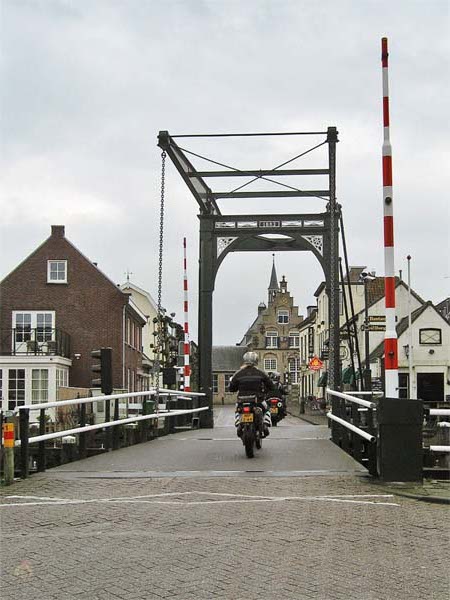
The Netherlands are a small country, densely populated, with strictly regulated traffic.
Nonetheless, there are beautiful roads for motorcycle riders, both with respect to cornering and to getting a glimpse of what makes the Netherlands so special.
On this page, you find information about traffic rules and habits, about good roads for motorcycle riders, about finding places to stay, and other tips for your visit.
The language
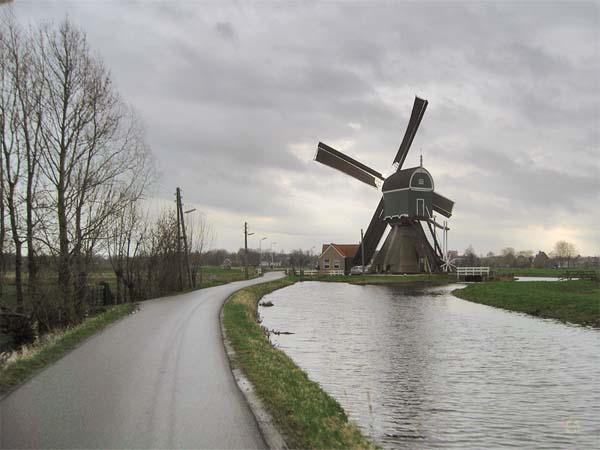
Dutch
In the Netherlands, people speak Dutch, or, like we call it, "Nederlands".
You will probably never meet someone who doesn't speak English: foreigners who want to learn Dutch often complain that it is impossible; everyone speaks English with them.
Many people also speak a bit of German (though they often don't like to admit that fact), and some people speak some French or Spanish as well.
Some words
Don't be disappointed when people don't understand you when you try to speak some Dutch words: they expect you to speak English. But they will appreciate it very much once they understand you really try to say something in their language.
Yes, ja
To say yes, you say "ja". Tha "j" is pronounced as in yes, and the "a" is pronounced as in dark, but then longer, like in Haagen Das.
No, nee
To say no, you say " nee". The "ee" is pronounced as the ay in may or way.
Thank you, dankjewel
Thank you is "dankjewel" in Dutch. The "a" is pronounced as in dark; the "nk" as in ink, the "j" as the y in yes, the "e" as the e in the, and "wel" as well. The emphasis is on the last syllable.
Here you are, please, alsjeblieft
Both here you are and please are "alsjeblieft". Again, the "a" is pronounced as in dark, the "j" as the y in yes, and the "e" as the e in the. The "ie" is pronounced as the e in here. The emphasis is again on the last syllable.
That will be all that you will ever need in the Netherlands, but if you want to know more, you could have a glimpse on this site about Dutch for travellers.
Traffic rules

Maximum speed
Without signs stating otherwise, maximum speed is:
- 50 km/h in urban spaces,
- 80 outside,
- 100 km/h on what is called "autowegen", which are marked with a square blue sign with a car on it,
- and 120 km/h on motorways, which are marked with a blue sign with a motorway on it.
The Netherlands have a really dense network of speed camera's and other mechanisms to get you a ticket when speeding, like "traject control". Especially on motorways, speeding is risky unless you don't mind paying the fine.
Right of way
In the Netherlands, traffic coming from the right has the right of way, unless otherwise stated.
Otherwise stated can be in the form of a red and white upside down triangular sign that tells you that you have to give right of way on the crossing to the other traffic. A row of white triangulars on the road tells you the same.
A square orange with white sign on the other hand, tells you that you are on a road that gives you the right of way at crossings.
Keep to the right
On motorways, there is no "keep your lane" system. The idea is that you go back to the rightmost lane after you have passed someone.
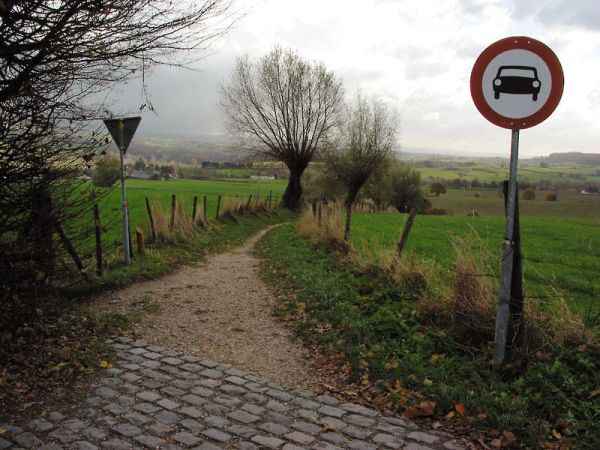
Bicycles
Beware of Dutch bicyclists!. In the first place, they do have the right of way when they come from the right (even though many Dutch drivers seem to forget the fact).
On top of that, they seem to swarm around you in the cities, cycling through red lights
and swerving to the left without looking and such. That's culture, even though the police
sometimes tries to maintain a bit of order.
Just be very carefull not to hit one. At night as well: occasionally, you will pass
a bicycle without lights.
Signs
Most signs speak for themselves. Noteworthy is that the sign on the photograph means that cars may not enter, but motorcycles can. Such a sign specifically has to show a a motorcyclist in there.
On the other hand, when a round sign with red border shows two cars next to each other, it means that passing is prohibited, for motorcycle riders as well.
Links
The Dutch ministery of traffic has a brochure with the Dutch traffic rules translated in English (if the link doesn't work, try find it on the Road and traffic safety page).
You might also take a look at this overview of signs.
Traffic culture

Lanesplitting
Lanesplitting is not forbidden in the Netherlands, but there are some rules you should adhere to on motorways:
- You should ride between the leftmost lane and the lane next to that lane, and
- The difference in speed between you and the cars should not be too big.
Try to watch your mirrors, and let other motorcycle riders who are faster than you pass you.
At traffic lights
In the Netherlands, you can also split lanes to ride to the front of rows of cars for a red light. Of course, you should be fast enough when the light turns green: the cars should not have to wait for you.
Bicycle riders
Something you should really be prepared for is the number of bicycle riders you will
meet. In cities, it seems like they don't have to obey traffic rules (they have), and
you should especially remember that they have the right of way when they come from
the right.
On sundays, many of the roads that are pleasant for motorcycle riders will be full of
bicycle riders as well. Sunday isn't the best day for a ride, in the Netherlands...
Safety risks: stolen bikes
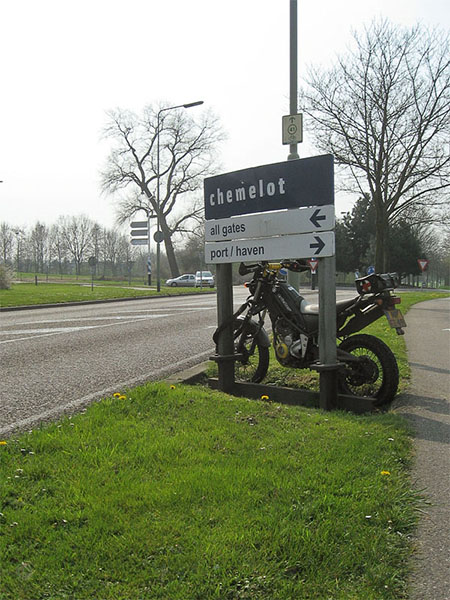
Risk of stealing
Unfortunately, the risk of having your motorcycle stolen in the Netherlands is rather high.
Areas which are especially dangerous are the big cities (not only Amsterdam), and all places where there are lots of motorcycle riders, such as in the south of Limburg, which has the additional attraction for thieves that the borders to Belgium and Germany are close by. Police forces of the three countries work together, but it still is a lot easier for thieves to get away unpunished.
Even when in plain sight
Don't think you are safe when your motorcycle is in plain sight. There have been thieves who come on motorcycle (two thieves on one), act as though they admire parked bikes, and then ride away on a bike of someone who is sitting a few meters from his bike...
Lock and hide
So, always secure your motorcycle with a lock, attached onto something solid. And when you're out of sight, make sure it is in a garage: the motorcycle on the photograph was stolen on this spot...
At what time do the Dutch eat?
Breakfast
A Dutch breakfast consists of "boterhammen" (slices of bread) with butter and slices of cheese or meat, peanutbutter or "hagelslag" (small pieces of chocolate). And there will be coffe or tea as well.
In a hotel, you will often be served toast and rolls as well, and sometimes there is a boiled or scrambled egg.
For bread, the Dutch like full grain bread ("volkoren"), but there is white bread as well.
Lunch
For lunch, taken between about 12 and 2, the Dutch eat the same as for breakfast. In cafés, you have often a choice of small warm meals for lunch. A typical Dutch dish (or rather, the name is typical Dutch) is an "uitsmijter": boterhammen with ham and cheese and three fried eggs on top (you will have to ask a Dutchman to pronounce it: both the "ui" and the "ij" are never heard in the English language).
Dinner
Dinner is traditionally served at 6 pm. Nowadays, many people eat later than six, and restaurants serve until later as well, but 6 pm still is the time most people eat. Dinner is the main course, and for many Dutch, the only warm meal of the day.
Where and what to eat?
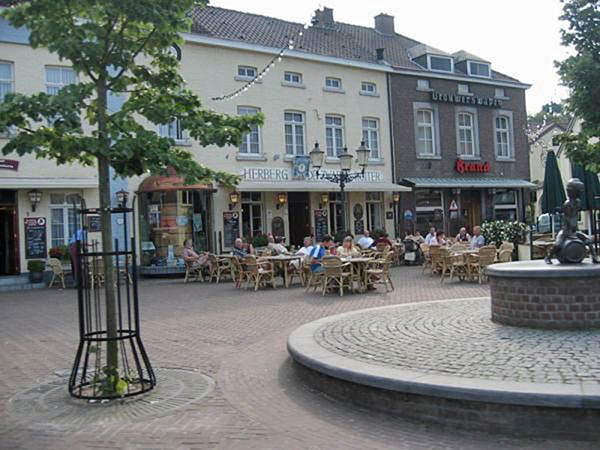
Pannenkoekenhuis
Something very Dutch is a pannenkoekenhuis, or "pancake house". When you search with the word pannenkoekenhuis you will get lots of sites. They are often situated in rural surroundings in an old farm. They often serve "ordinary" food as well, but you should of course order a pancake: you will get a very big one, and you can choose between lots of toppings.
Eetcafe
An "eetcafe" is a cafe where you can order a meal as well. Simple, cosy, and often a good quality/price ratio.
Snackbar
Snackbars sell chips, "kroketten" and other junkfood. They allow for a quick and cheap meal.
Restaurants
Restaurants come in many forms. Almost every town has a Pizzeria. Lot of towns also have a Chinese restaurant: the Chinese were among the first who started restaurants with non-Dutch food, and for a long time, they were the only foreign restaurants. Nowadays, you can find restaurants from all over the world, and sometimes, you will even find a restaurant that serves Dutch food.
Stamppot
More and more restaurants serve traditional Dutch food. One such a meal is "stamppot", which consist of mashed potatoes and vegetables and meat. "Zuurkool stamppot" is sauerkraut mashed with potatoes, with lard and other meat; "hutspot" is mashed carrot, onions and potatoes with meat, and "stamppot rauwe andijvie" is mashed endive and potatoes with meat. See this recepy for hutspot.
Another Dutch meal is " erwtensoep" or "snert": a thick soup of peas. More typical Dutch food over here.
What to drink?

Beer
There are several Dutch brands of beer (the Dutch word is bier, and it is pronounced the same as beer). You probably know Heineken; it is sold everywhere, but it is certainly not the best tasting beer of the Netherlands.
Grolsch is a better brand, from the east of the country (the name means "from Groenlo").
The south-east of the Netherlands, Limburg, has several brands that are still produced using the local ingredients. You can visit the Gulpener Brewery in Gulpen (site only in Dutch, I'm afraid).
The Brand Brewery in Wijlre (a few kilometers from Gulpen) is now owned by Heineken, but they still make the same beer that they're making for ages.
The Alfa Brewery is another Dutch Brewery, in Schinnen (close to Gulpen and Wijlre). Their beer is very tasty!
Most cafes serve several kinds of draught beers, and more bottled ones. Especially Belgium beers, because Belgium has many special breweries.
Wine
There are a few wineries in Limburg, and it's possible to visit some of them. I couldn't find websites with a version in English, but you can always contact the Tourist information of South Limburg.
Non-alcoholic drinks
The Dutch love to drink coffee: every cafe or bar will serve it. And because you shouldn't ride after drinking alcohol, there is a variety of non-alcoholic beers as well.
Where to stay?
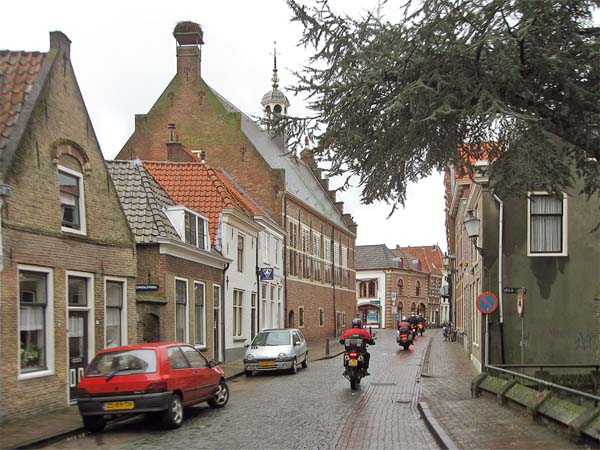
Campings
There are a few campings especially for motorcycle riders in the Netherlands:
Motorcamping d'n Toerstop (site in Dutch and English) is situated in the north of Limburg.
Motorcamping and Bed & Breakfast het Dijkje (site in English) lies between the so-called "big rivers", ideal for riding the Dutch dikes (see below).
Motorcamping In den Hof (site only in Dutch) is in south Limburg, one of the most beautiful regions of the Netherlands.
Other campings will welcome you as well. There are relatively many campsites in the Netherlands. See for instance the Dutch city camps.
Bed & Breakfast and Hotels
There are some Bed & Breakfasts or hotels especially for motorcycle riders:
the Bike Motel in the north of the Netherlands.
Hotel La Chaussee is in south Limburg.
Bed & Breakfast accomodation Immerloo is situated in Arnhem.
Other hotels will welcome you as well. Try Booking.com.
Tourist Information
The Dutch Tourist Information is called the "VVV".
Every town and many villages have one, like the one here in the photograph (you see a sign on one of the white houses on the left side of the street).
Finding motorcycle roads: the dikes
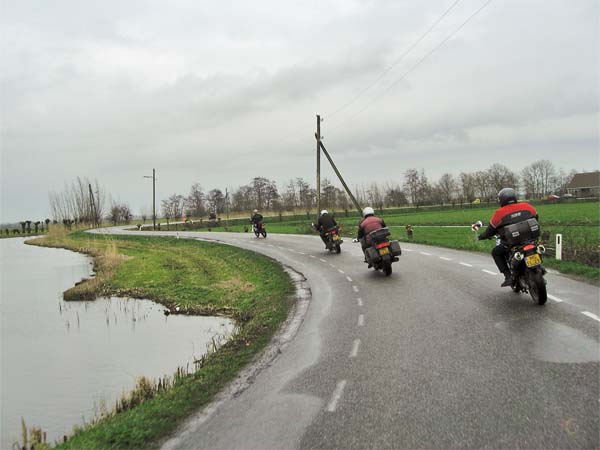
dikes
No, we don't mean dikes on bikes; we mean bikes on dikes.
The Dutch have built their dikes centuries ago to protect the land against flooding from the rivers. And because rivers don't run straight, the Dutch dikes make excellent motorcycle roads.
In late summer, the reeds will be so high that you don't have optimal view anymore, but before that, you will have an excellent view of the corners before you.
Where?
There are dikes along all the big rivers. In Rotterdam for instance, you can follow the Lek beginning on the Molendijk (see map). You can follow the dike along the Lek until Wijk bij Duurstede or Rheden.
The river the Waal is another one. You could start on the Waaldijk in Gorinchem (see the map), follow the dike until Nijmegen and beyond, on either side of the Waal.
Smaller rivers
Smaller rivers with beautifull roads alongside, giving you a view of how the Netherlands used to look like, are:
Finding motorcycle roads: ANWB routes

ANWB routes
The Dutch automobile organisation, the ANWB, has some signposted routes that give you an overview of Dutch landscapes. You can follow the signs.
The signs are brown hexagon-shaped signs, like you see in the photograph.
Those routes are:
- The Bollenstreekroute through the region of the coloured bulbs, starting in Katwijk, near the North sea and the dunes,
- the Dijk- en Duinroute in the north of Noordholland, with old towns, dunes, bulbs and dikes, starting in Schagen,
- the Friese Merenroute in south-west Friesland takes you through the lakes region of Friesland, with old towns and green pastures, starting in Sneek,
- the Heuvelrugroute through forests and along old stately homes in the centre of the Netherlands, starting in Bunnik,
- the Hondsrugroute takes you to the Dutch Hunebeds (graves from prehistory), and through moors and forests, starting in Gieten,
- the Koggenroute leads you to land that is almost water, along the IJsselmeer (which used to be a sea: the Zuiderzee), and along very old vollages and museums about the old days, starting in Zuidoostbeemster,
- the Krekenroute runs through the south-west of Zeeland, which has known a big disaster when the sea destroyed the dikes. You see villages now safe because of the Deltawerken (huge dams and dikes), and you will see the influence of the North Sea everywhere, starting in Terneuzen,
- the Lek en Lingeroute takes you to the land between the big riverarms, with windmills, old vollages and towns, and fruit trees, starting in Arkel,
- the Mergellandroute takes you through the only landscape with steep hills of the Netherlands, through picturesque villages with half timbered houses, along the only vineyards of the Netherlands, and along small cafe's and restaurants everywhere, starting in Maastricht,
- the Nieuwlandroute, through the region that used to be the bottom of the Zuiderzee: long straight roads, but still, it was the bottom if the sea..., starting in Almere,
- the NoordVeluweroute, through forests, along castles, and inland sand dunes, starting in Apeldoorn,
- the Noordwest Overijsselroute along what used to be the coast of the Zuiderzee, with villages of fishermen, and Hanzesteden, towns that became rich in the time of the Hanze, trading with Germany, Poland and Scandinavia, starting in Staphorst,
- the Peel en Maasroute, through what used to be a wilderness of moors and marshes, starting in Walsberg,
- the Sagenlandroute, through a region with gentle rolling hills in the east of the Netherlands, starting in Hengelo,
- the Strijd tegen het Water route, in Zeeland, the region that was hit by a great flooding, with ancient villages, starting in Noordwelle,
- the Taxandriaroute, crossing the borders of the Netherlands and Belgium, starting in Alphen-Chaam,
- the Terpenroute through Friesland, in the region where farms and villages were built on so-called terpen, man-made hills, to be safe from the sea, starting in Leeuwarden,
- the Veen- en Wouderoute, through sand dunes, moors and so-called laagveen: very wet ground where turf was carried away to be used as fuel, starting in Beesterzwaag,
- the Wad- en Marenroute, through farmland with so-called mares, canal-like ditches that could carry away the water when the Waddenzee flooded, starting in Winsum,
- the Zuid-Veluweroute, along forests and stately homes, starting in Arnhem.
In all cases (especially in case of the Mergellandroute), you should avoid sundays.
What to see? Towns
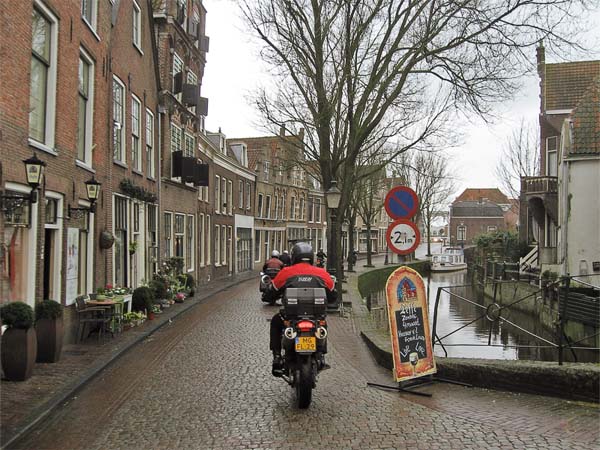
Amsterdam
Many Dutch towns have centers that were built in the "Golden Age", the 17th century, when the Dutch traded over the whole world and were very rich (at least, some of them).
Amsterdam is an example of such a town, and it has a big 17th century and earlier center, with the famous canals.
Riding on a motorcycle through Amsterdam is a special experience. There are trams, many bicycles, many people on foot crossing the streets without looking, and bridges over the canals.
Many smaller towns
There are many smaller towns in the Netherlands with picturesque old centers. Delft is a famous example (because of Vermeer and Delft blue tiles), Gouda is another famous one (because of the cheese and its pipes), Oudewater is a beautiful small town.
There are many more, such as Hoorn, Sneek, Maastricht, Zutphen, and many many more.
No matter where you will spend your time in the Netherlands, there will be small towns with old centers.
What to see? the Coast
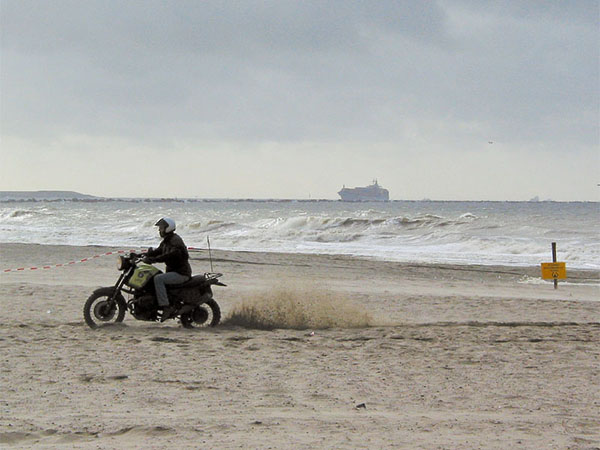
North Sea beaches
The Netherlands have broad sandy beaches, all along the coast of the North Sea.
On the photograph, you see the beach at Hoek van Holland, which has the extra bonus of big ships, sailing to and from the ports of Rotterdam.
On sunny days during summer, the beaches will be full of people, and the roads that lead to the sea will be jammed with cars. Of course, on motorcycle, you have the adventage of being able to pass those cars, but it might be a good idea to admire the North Sea and its beaches on a day that is less suitable for sunbathing.
Note, hoewever, that riding on the beach is forbidden everywhere: the action on this photograph is illegal...
Sand dunes
Between the beaches and the land inside are sand dunes, sometimes over a broad area. The sand dunes are as well strictly forbidden territory for motorcycles.
Wadden Islands
The Netherlands has on its northside a series of so called Wadden Islands. To the north side, they have long sandy beaches, and to the south side, they face the "Waddenzee", a sea that has a muddy bottom, and is so shallow that parts of it are without water during low-tide.
The people on these islands have always been living with and off the sea (and
nowadays off tourism).
Texel (pronounced as tessel) is the biggest island;
Terschelling is, I think, the most beautiful.
Note that Vlieland and Schiermonnikoog don't allow cars or motorcycles!
Fisherman villages
There are several villages along the coast that have a history of fishing. Scheveningen (now inside the Hague) and Katwijk are examples.
Along the coast of what used to be the Zuiderzee, and has become a lake because of the "Afsluitdijk", are fisherman's villages that retained much of their character.
Volendam is a famous example.
Suggestion: Noord Holland
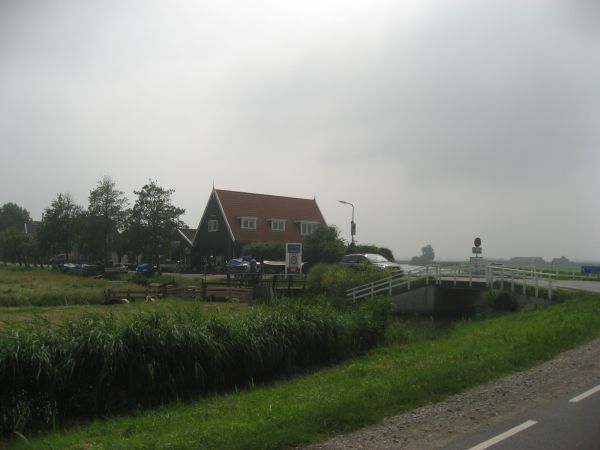
Water
Noord Holland is not only almost surrounded by water (the North Sea to the west, the Waddenzee to the north, and the IJsselmeer to the east); it has also some of the oldest "polders" of the Netherlands: land that below the surface of the sea, made dry using pumps.
Old towns
Amsterdam (itself full of water) lies in Noord Holland, and of course you should visit it.
But there are many old towns or villages to visit:
Volendam is a famous old fishermen's town,
The Zaanse Schans is a well-preserved typical
Noord-Hollands village, worth visiting. And there are more old towns, such as Hoorn and
Enkhuizen.
And Bergen aan Zee is a beautifull village in the dunes near the North Sea coast, popular with artists since long ago.
Staying there
Every village or town near the coast has plenty of camping sites and hotels: it will never be a problem to find a place to stay. You can also book through Booking.com.
Suggestion: Zuid Limburg
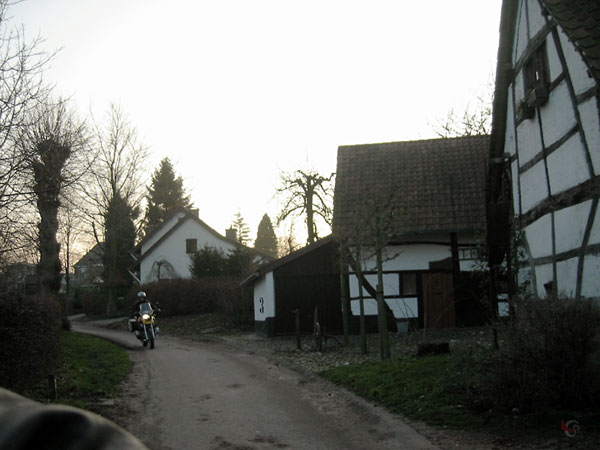
Motorcycle country
The south of Limburg is a typical motorcycle country: hills that make curves in the many roads, varying from broad to very narrow, leading from village to village, and very few traffic lights (none if you keep to the narrow roads).
Because there is such a great choice of roads, and because the landscape is very small-scale, each ride will be a pleasure.
Staying there
Another pleasant propery if the south of Limburg is that there are plenty of places to sleep, plenty of places to eat good food, and to drink good beer or whine.
Every village has at least one cafe, and often more. Almost every village has a restaurant or a cafe where they serve food as well. And almost every village has at least one hotel or camping. And because there are many villages, the choice is abundant.
You can also book through Booking.com.
Traditions
If you're lucky, you might bump into a procession, or parade, or the " getting of the may fir", or another traditional event. Each village has several of such events, vaguely (or not so vaguely) catholic, that take place each year again, in the same way as it has been done for ages.
Eiffel and Ardennes
On top of that, the (German) Eiffel, and the (Belgium and Luxemburgish) Ardennes are very close by as well, providing even more motorcycle roads.
Comments, Q & A, on a separate page




